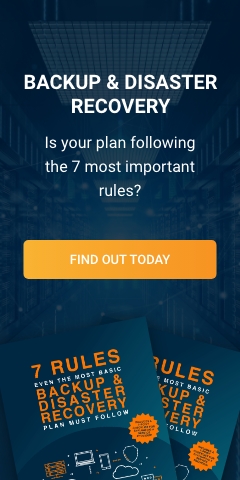Like ‘cloud computing’ and ‘Internet of Things,’ downtime is a buzzword that small-business owners often throw around. So, before we can talk about how to calculate it, we need to define it. Downtime is the duration of time a system is unable to perform its primary function. And for SMBs with limited financial resources, downtime can lead to permanent closure.
When vital applications or entire networks suddenly fail or crash, your business comes to a grinding halt. And unless you have sufficient backup and disaster recovery solutions in place, it’ll stay there and cost you a pretty penny. If you’ve never stopped to assign actual dollar amounts to downtime, you might be shocked to see the numbers.
Finding your formula
Calculating the average cost of downtime depends on numerous factors: which industry you’re in, the duration of the outage, the number of people affected, and the time of day, just to name a few. For example, per-hour losses are significantly higher for businesses that rely on high-level data transactions such as banks and online retail sales.
Since 2008, Information Technology Intelligence Consulting (ITIC) has conducted annual surveys that measure the cost of downtime. ITIC has found that the cost of a single hour of downtime has risen by 25-30%. According to this year’s study, the average cost of a single hour of downtime is now a jaw-dropping $100,000. Additionally, 81% of respondents indicate that an hour of downtime costs them over $300,000, while others report a seven-digit figure.
Of course, an average value that covers multiple industries is just a benchmark. You’ll want to figure out the cost of downtime specific to your business.
Calculating cost of downtime
The formula is lost revenue + lost productivity + cost to recover + cost of intangibles = cost of downtime. While some components are harder to calculate than others, here’s how you can quantify revenue and productivity. The constant here is that applications are completely unavailable and productivity is at a standstill. Let’s say there are 50 users on your server, and that they each make $40,000 per year. That’s about $19-21 per hour with benefits. 50 users x $21 per hour x 100% loss of user productivity totals at $1,050 per hour. Or, for every hour of downtime, you lose $1,050 of direct productivity.
As for calculating lost revenue, start by identifying which business area generates the highest revenue. Firstly, divide your weekly average revenue by 40 to get the business area revenue generated per day. Secondly, estimate the percentage of your business that relies on server uptime -- is more revenue generated online or not? Thirdly, calculate the amount of hourly revenue lost during downtime for each business area.
For example, say your business is an eCommerce website that generates $100/hour. If that website is offline for two hours, you lose $200. Add the figures for these different revenue-generating areas to get the total cost of downtime per hour for your business.
What to do with your downtime calculations
When creating disaster recovery plans, understanding the cost of downtime is crucial. Every plan should have two things:
- A Recovery Time Objective (RTO): the maximum tolerable length of time that a computer, system, network, or application can be down after a failure or disaster occurs.
- A Recovery Point Objective (RPO): how recent you need your recovered data to be. Can you live without data for a week? Or do you need mission-critical data to be recovered within 12 hours?
RTO and RPO should be based on what the cost of one hour of downtime is for your business. RTO will depend on how many hours of downtime you can weather when a disaster strikes, and RPO will change based on how much retroactive downtime you can afford.
It’s not always about the money
However, downtime isn't always about cash. If your business experiences an unexpected outage, not only do you risk losing money, but you also risk damaging your company's reputation. Say a customer needs to make a particular transaction; if they can't make it when they want, chances are they're going to find another company that can accommodate their needs and spread the word that you’re unreliable.
As for your employees, downtime has a huge impact on motivation, and the only thing they have to look forward to is getting back online. This temporary glitch lowers morale and impacts customer service.
The last thing any business wants to deal with is downtime. Mainly due to its exorbitant price, but also the sudden interruption to daily operations. To prepare for these unexpected events, business owners need an efficient and reliable data backup and recovery solution that prevents a blackout from becoming a knockout. With Complete Technology as your IT partner, the only KOs you’ll be dealing with is your competition’s.


